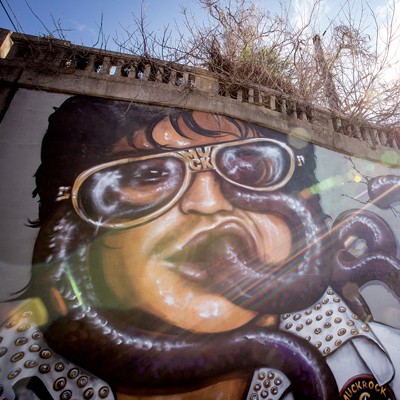
Controversial Elvis Presley mural painted on a public underpass wall
After the city unintentionally painted over seven Paint Memphis murals last week, instead of the ones the city council identified as offensive and requested be removed, the mayor’s office issued a temporary stay on buffing murals.
This is to give Karen Golightly, director of Paint Memphis, one more chance on Tuesday to ask the council to rethink its position on the murals which some of its members in the past have deemed “satanic.”
Those include paintings on public right-of-ways of Elvis Presley with a snake coming from his orifices, a cow skull, and a dancing skeleton, as well as a zombie painted on private property.
Golightly said she wants the council to better understand the pieces in question and see the artists’ intentions.
She also wants them to know the legal ramifications that could result in removing the murals, as the work of visual painters is protected under the Visual Artists Rights Act.
[pullquote-2]
The mayor’s office also recommended that Golightly meet with council members individually to try to come to an understanding, but after reaching out to all 13 members, only Philip Spinosa responded, she said.
“I want to see if there’s some middle ground we can come to,” Golightly said.
If no middle ground can be reached, Robert Knecht the director of Memphis’ Public Works said the city will move forward with removing the murals on the public right-of-ways.
But, erasing the zombie mural painted on a Lamar Avenue private property, Knecht said, will require legal recourse.
 Justin Fox Burks
Justin Fox Burks
Karen Golightly, director of Paint Memphis with zombie mural city council members called ‘satanic.’
Since the mural was approved by property owner Pat Surratt, the work can’t be considered as graffiti under the city’s graffiti ordinance and therefore cannot be removed without Surratt’s consent or a court order.
The city will contact Surratt asking him to remove the painting, and if he declines, the issue could go to the Environmental Court.
From there, the court would have to declare the mural a public nuisance in order for it to be removed.
Moving forward, Golightly admits that Paint Memphis has “a lot of room for improvement” when it comes to engaging the community.
“We should have done a house-to-house survey,” she said. “We really are trying. We’re not perfect though.
Wherever we decide to we go from here, we hope we can both engage the community and respect artists’ rights. I don’t think those are mutually exclusive.”
Knecht of Public Works calls what happened last week an “unfortunate misunderstanding” that he wishes he could undo.
Leading up to the murals being painted over, the council sent a request to public works asking that six murals painted on public property near the Willet and Lamar underpass be removed.
The request, which included pictures of the specific murals that were to be painted over, was then forwarded to the city’s graffiti team.
Knecht said the graffiti team had no ill-intent but rather misread the request. He said perhaps he should have been more clear with the graffiti team.
Originally, Paint Memphis had proposed to paint the Downtown floodwall, Knecht said, but since it’s what he calls a “premiere space,” the artists would have been required to let the city know exactly what they would paint.
After Paint Memphis leadership said that the artists couldn’t do that, they asked if they could paint the underpass at Willet and Lamar without having to get the plans pre-approved.
They received the OK from Knecht’s office, but Knecht said he was “very specific” in his approval email, which he said stipulated that the city reserves the right to remove anything offensive or objectionable.
[pullquote-1]
“It was clear that if anything went up and we didn’t like it, then we could take it down,” Knecht said.
In the future, Knecht said the city will work more closely with community members to determine what kind of art they want in their neighborhoods.
“I mean, I’m not an artist, but I support art and you know I think it’s good,” he said. “But, I also see that the community should have a say in what’s in their community. I think they have the strongest voice in this.”
Knecht adds that the city is considering requiring that all mural proposals go through a more thorough process and be heard by the city council who will decide if the project should proceed or not.
He said he’s spoken to the mayor at length about this issue and he, along with the council, agree that there needs to be a more formal process.
The process would most likely require preliminary sketches or other details in advance, said Knecht.
“Allowing someone carte blanche or free rein to put up whatever they want is very difficult,” he said. “We need to have more of a vetting process, I guess.”